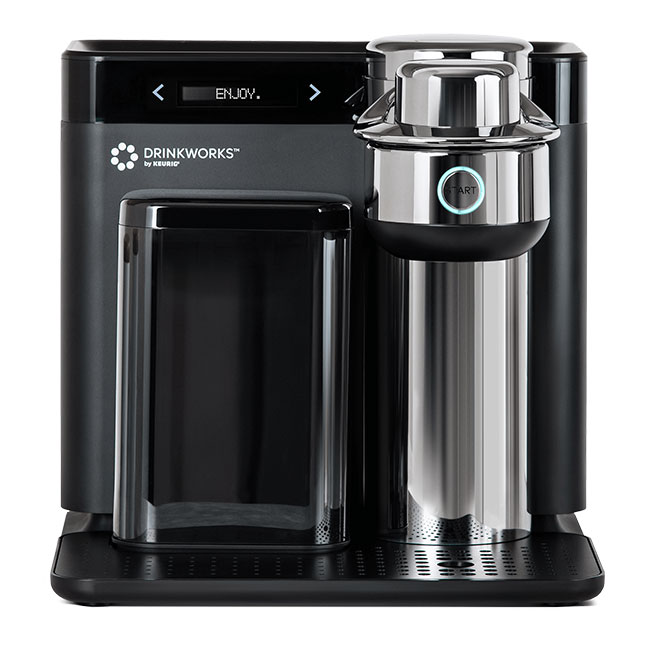Looking for the right mix
 Disruption, with all of the chaos that the word implies, is generally seen as a good thing if you’re the one causing it. However, marketing a disruptive product comes with a variety of its own hurdles and the ways in which companies overcome these barriers to reach consumers can make or break a product.
Disruption, with all of the chaos that the word implies, is generally seen as a good thing if you’re the one causing it. However, marketing a disruptive product comes with a variety of its own hurdles and the ways in which companies overcome these barriers to reach consumers can make or break a product.
Drinkworks, a joint venture between Anheuser-Busch InBev and Keurig, had just launched its own disruptive new product, a single-serving cocktail maker called the Drinkworks Home Bar. The product was available for purchase in five brick-and-mortar stores all located in St. Louis. In preparation for a move into additional expansion markets and ultimately a national launch, Drinkworks wanted to optimize its product and marketing strategy – but in order to do this it needed to understand which aspects of its current strategy were working well and which were not.
Make the user the hero
To accomplish this, the company partnered with AMC Global, a research firm with experience helping launch products. It was critical to Drinkworks that insights were gathered from actual purchasers of the new product, but with very few units in market, the company knew this would be an incredibly challenging task. Drinkworks knew that it wanted to design a research process that enabled the consumer to drive decision-making. In fact, one of the “Five Principles” of Drinkworks is to make the user the hero, so this involvement was crucial. With this in mind, the company planned to use a test-and-learn approach to gather insights and improve its product.
The research plan began with AMC Global’s PFU (purchaser follow-up) methodology, which gave the companies a way to recruit a robust sample of new product purchasers immediately after launch and understand their experiences with the product over time. Using a variety of quantitative and qualitative methodologies, the companies conducted research to better understand the purchaser/user perspective and the shopper perspective, as well as the broader, market-level perspective.
Beyond tools and methodologies, an ongoing challenge for the research was the need for agile insights at a near-constant pace. “Drinkworks’ goal is to learn from every consumer touchpoint and allow the insights to drive decision-making,” says Jessica Bolger, director, consumer insights, Drinkworks. “Because these decisions are being made every day, we often don’t have the luxury of time. We need to provide accurate and actionable insights that are senior-management-ready within hours and days instead of weeks and months.”
Real consumers in real moments
The newness of the product, as it turns out, did not end up being a barrier to the research. Because the most critical aspect of the research program was to talk to real consumers in real moments, the disruptive quality of the product could be overcome in testing. For most studies, consumers weren’t actually presented with the product. Instead, the companies reached consumers as they experienced the product in market – from seeing it in store, to trying a sample, to buying it, setting it up at home and using it over time.
When recruiting target buyers for broader objectives and introducing them to the product, Drinkworks shows a traditional concept and descriptive video for the product. The video simulates what a consumer might find when shopping in a store or on the Drinkworks website. Therefore, it provides the same information that consumers would naturally have prior to buying in market.
Qual and quant angles
Using AMC Global’s ResponseCash PFU (purchaser follow-up) methodology, the companies recruited the very first purchasers of the Drinkworks Home Bar to participate in online or mobile research during the initial test market launch. The ResponseCash system uses in-pack or on-pack survey invitations to recruit purchasers of new products into survey research. For their participation, respondents receive a prepaid cash-card incentive. For this research, survey invitations were designed and placed in product packages prior to the product being shipped to stores. Additionally, Drinkworks leveraged a significant incentive ($80) in order to recruit a quantitative base size of actual product purchasers, even when only a few hundred machines had been sold. 
The Drinkworks Home Bar is a single-serving, pod-based drink maker for cocktails, beer and more.
This method of inviting and incenting respondents ensured a robust and representative response to the survey. A sample size of 180 purchasers participated in the first phase of the research. These hard-to-reach respondents would have been impossible to find via more traditional methods such as online panels. This methodology also allowed the companies to follow up with purchasers over time. Here, purchasers were recruited to participate in three phases of research corresponding to key usage periods – immediately after purchase, after six weeks and again after six months of usage.
Because Drinkworks had a desire to connect with real Drinkworks buyers on a deeper level, it also utilized shop-alongs and in-home ethnographies. “Qualitative insights would be a critical supplement to the quantitative research and help to bring the consumer experience to life for the organization,” says Erin Russeck, EVP, corporate strategy and innovation, AMC Global. “Immediately following the launch of the Drinkworks Home Bar, shop-alongs and in-home ethnographies were conducted in order to see consumers’ experiences with the Drinkworks system firsthand. Specifically, we sought to gauge purchasers’ first impressions of the Home Bar when they purchased in-store, brought it home, set it up and used it for the first time.”
In addition to understanding the product’s launch through initial buyers, Drinkworks also wanted to better understand sampling and demonstration efforts in the first launch market in order to optimize the sampling strategy moving forward. From the initial stages of the research, the companies hypothesized that sampling and demos would be a critical component of the marketing plan in driving purchase. Not only was this product disruptive, but it also came at a high price point and it was reasonable to assume that consumers would want to try it before buying it. Using SampleTrak, Drinkworks sought to confirm this hypothesis while also better understanding the role of sampling on strategy. Specifically, Drinkworks needed to understand who it was reaching through the sampling efforts, as well as the impact on conversion to purchase.
Drinkworks also wanted to know how successful it had been thus far in building awareness and purchase in the market, as well as what attributes were most associated with the brand. To learn more, the companies conducted a multi-wave attitude and usage study with alcoholic beverage consumers timed with critical moments in the launch.
Finally, it leveraged actual purchasers from the PFU and recruited target consumers to conduct custom research including qualitative focus groups and conjoint research in order to inform the innovation pipeline. “Even the most challenging studies were successful,” says Russeck. “For example, within the first few weeks of launch and with less than 500 machines sold, we were able to recruit a quantitative base size of 180 actual product purchasers to participate in our research program.”
Strengths and weaknesses
As planned, the research helped Drinkworks to uncover some strengths and weaknesses of the Home Bar launch. Many of the findings were positive signs for the new brand. For instance, through the research Drinkworks found that it was reaching its intended target of consumers of alcoholic beverages. Home Bar purchasers had an understanding and appreciation for the uniqueness of the product, citing novelty, convenience, value for entertainment and the wide variety of drinks as the top purchase motivators. The product had also gained some buzz, with many consumers in the initial market learning about it via word of mouth. Finally, purchasers liked the drinks and were ultimately satisfied with the product.
The research also enabled Drinkworks to improve certain aspects of its product and marketing strategy. For example, as a result of this research program, Drinkworks modified the Home Bar’s quick-start guide to ensure that the setup process was clear and frustration-free. The company also improved its sampling and demonstration strategy in order to ensure that it reached a relevant target and drove conversion. Finally, it developed various strategies for increasing consumer value and driving NPS scores. Specifically, Drinkworks made changes to the price and promotion strategy, the innovation pipeline and brand communications.
On the consumer’s level
While the disruptive nature of the Drinkworks Home Bar could have become a barrier to the product’s launch in additional markets, Drinkworks avoided this outcome by truly getting on the consumer’s level to understand the motivations of those who were already deciding to purchase the product. This enabled the company to not only capitalize on those aspects of the product that drew consumers in but also remedy any pain points that arose within the entire purchasing process – from when a potential buyer first laid eyes on the product to when they brought it home and tried it out for themselves.
This outcome was the direct result of Drinkworks’ desire to “make the user the hero” – which the company accomplished by gathering insights from purchasers through the entire buying and usage process and even beyond – enabling consumers to drive decision-making.
